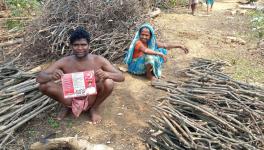Tamil Nadu: NFHS Data on Teenage Pregnancy, Spousal Violence, Sex Ratio is Worrying
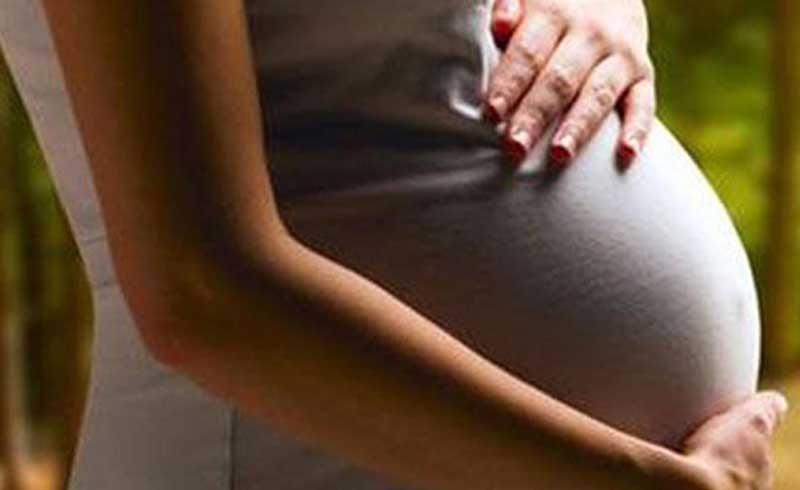
Chennai: Teenage pregnancy in Tamil Nadu has risen from 5% in 2015-16 to 6.3% in 2020-21, according to the phase II of the National Family Health Survey-5 (NFHS-5) data released on November 25.
This survey, which is conducted in a representative sample of households throughout India to provide essential data on child mortality, the practice of family planning, maternal and child health, nutrition, utilisation of health services and others, has revealed some alarming data on maternal health and childcare in Tamil Nadu.
For instance, Cesarean or C-section births have shot up by over 10% in Tamil Nadu over the past five years. Also, the percentage of children aged 6 months to 2 years receiving an adequate diet has reduced by nearly half.
Worryingly, the sex ratio for children born in the past five years in Tamil Nadu has dropped from 954 females recorded in NFHS-4 to 878 females for every 1,000 males in the past five years
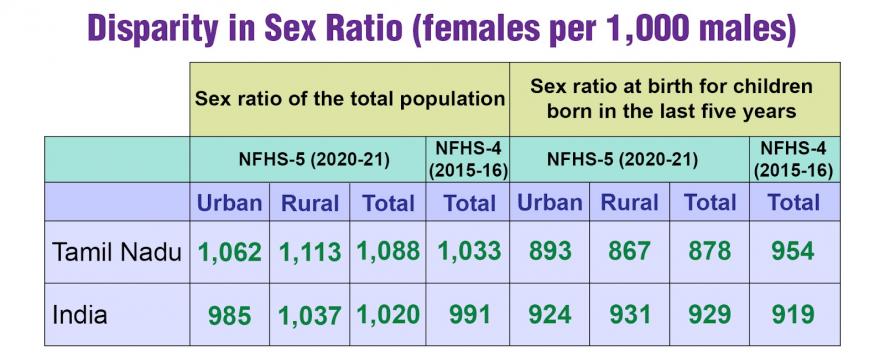
In addition, certain health issues predominant in urban areas, such as above normal blood sugar levels and obesity, are considerably above the national average in Tamil Nadu.
Surprisingly, at a time when many instances of child sexual abuse are coming out, the data gathered from 27,929 households for NFHS-5 says that young women aged 18 to 29 years, who experienced sexual violence by age 18, is 0% in Tamil Nadu.
The percentage of women who ever experienced spousal violence was highest in Tamil Nadu, 38.1% in the age group 18 to 49, while neighbouring Kerala recorded only 9%.
NewsClick has collated significant data on Tamil Nadu from the recently released phase II NFHS-5 data that depict the status of women, children and healthcare in the state.
MATERNAL HEALTH
An increase in women aged 15 to 19 who were already mothers or pregnant at the time of survey shows the bitter reality of child marriage in Tamil Nadu. Nearly two-third of the underage pregnancies has been reported in the rural areas.
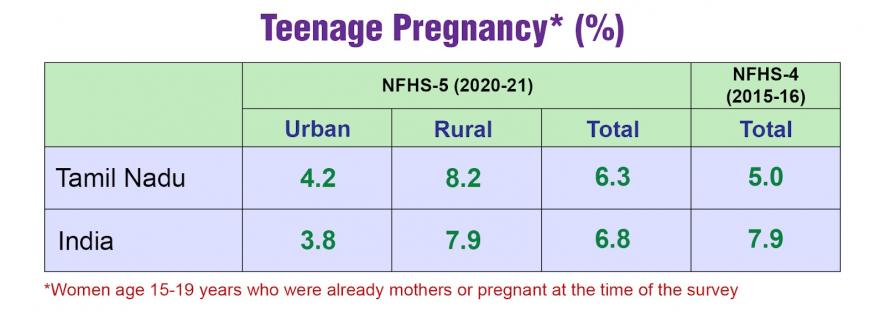
Notably, the all India average of teenage pregnancy has witnessed a negative trend, from 7.9% to 6.8% over the past five years.
The number of Caesarean deliveries is the second highest in Tamil Nadu at 44.9%, after Telangana which recorded right 60% C-section deliveries.
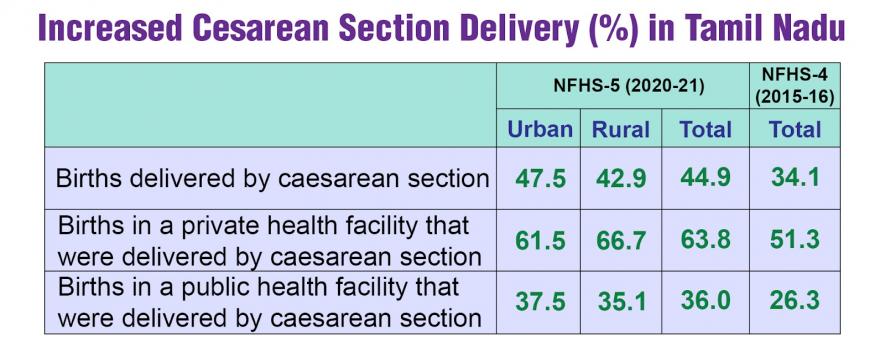
The number of C-section deliveries in private health facilities increased from 51.3% in the previous survey to 63.8% in NHFS-5. In public health facilities, these had increased from 26.3% to 36%. Such deliveries are particularly high in urban areas.
PUBLIC HEALTH FACILITES
The overall data show that the use of public health facilities has shot up compared with private facilities, which could be an outcome of the pandemic and allied financial constraints. This is especially visible with the increased use of public health facilities for vaccinations for children, from 85.1% to 89.8% in five years, compared with the decline in private health facilities from 14% to 10.1%.
However, the out-of-pocket expenditure per delivery in public health facilities has increased from Rs 2,609 in 2015-16 to Rs 3,316. Meanwhile, the national average logged a downward trend, from Rs 3,197 to Rs 2,916.
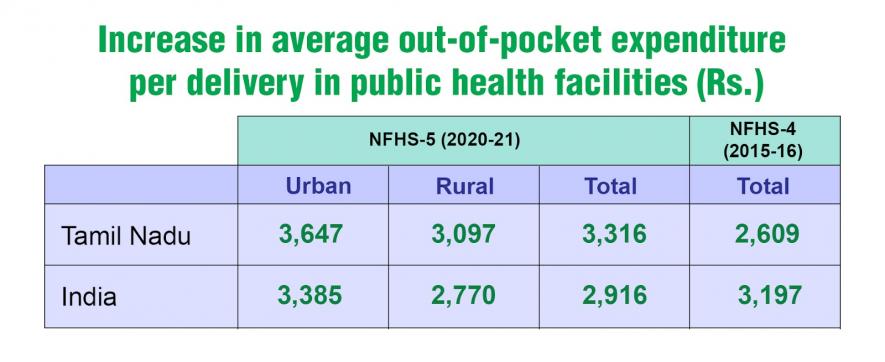
A positive trend is that home birth is nil in Tamil Nadu, 99.6% are institutional births and even the 0.2% out-of-institution births are conducted by skilled health professionals. Kerala is the only state above Tamil Nadu, with 99.8% institutional deliveries, while the national average is a meagre 61.9% institutional births.
CHILDCARE GAPS
Increasing anaemia among children and pregnant women, a rising trend at the all-India level, is also a cause of concern in Tamil Nadu.
Children aged 6 to 59 months who are anaemic have risen from 50.7% to 57.4% in the state over the past five years. Similarly, pregnant women aged 15 to 49 who have below normal haemoglobin levels have shot up from 44.4% to 48.3%.
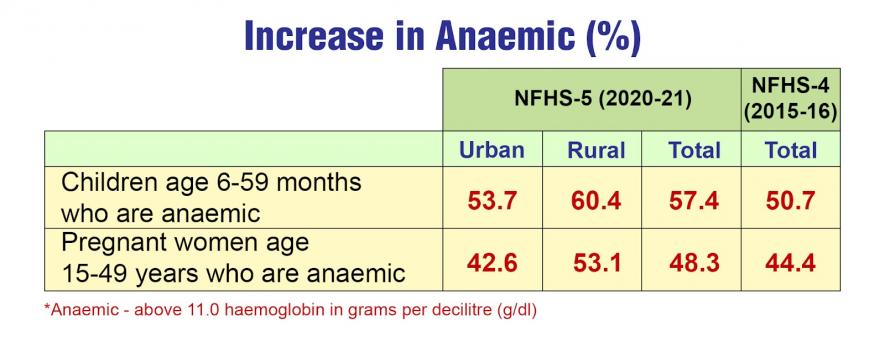
This is a direct reflection of the decline in the nutritional status of children. The total number of children aged 6 to 23 months, receiving an adequate diet, has starkly fallen from 30.7% to 16.3% in just five years, even while the national average marginally increased.
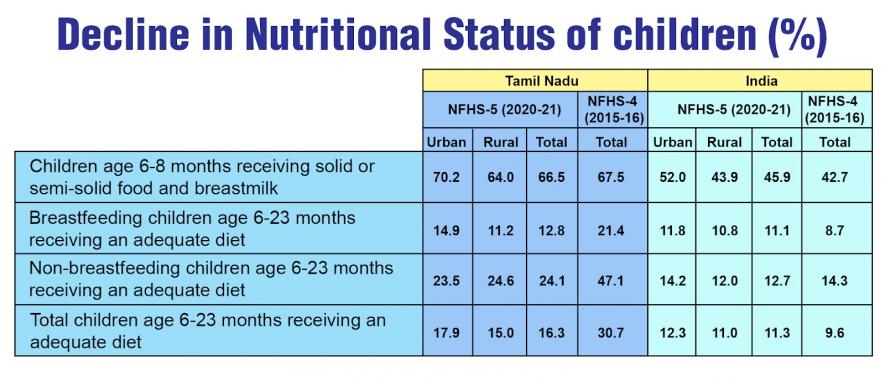
It is worrying to see that access to healthcare has reduced in certain aspects. Although the NFHS-5 data shows that cases of diarrhoea in children in the two weeks preceding the survey was much less compared with the period when NFHS-4 was collated, the access to health facility or health providers during the illness has considerably reduced from 73.2% to 60.2% in five years.
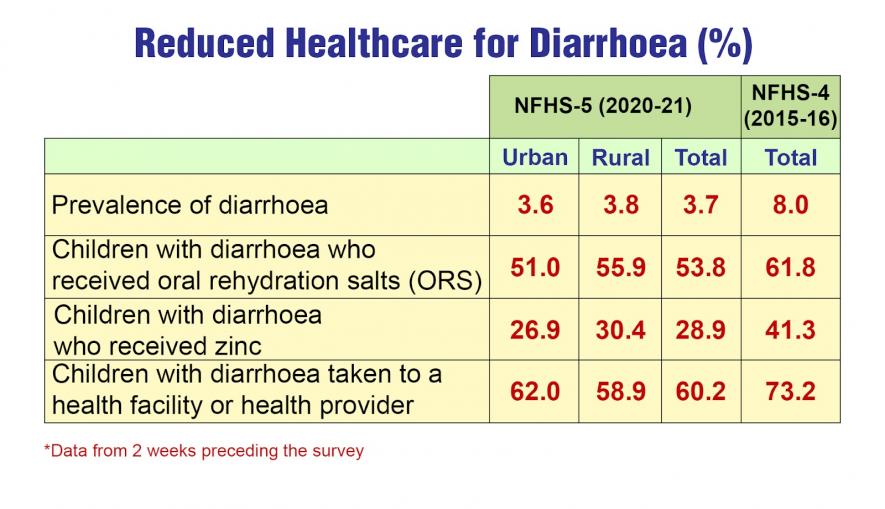
URBAN HEALTH ISSUES
The maternal and child health concerns mentioned so far were predominant in rural areas, but urban areas have their own set of health issues.
According to NFHS-5, 40.4% women were found to be overweight or obese in Tamil Nadu compared with 30.9% in 2015-16. Among men, 37% are obese or overweight against 28.2% in the previous survey.
Data also shows that around 20.7% have high sugar levels (above 140 mg/dl) or were on medication to control blood sugar. Hypertension is also more prevalent in urban areas.
A considerable urban-rural divide can be seen in access to the internet. The digital divide is also prominent between men and women. A significant 76.1% urban men said they had have accessed the internet compared with 55.8% women in urban areas; whereas 64.9% rural men have accessed the internet compared with 39.2% rural women.
Due to the COVID-19 pandemic and the imposition of lockdown, NFHS-5 fieldwork in the phase II states and Union territories were conducted in two parts. In Tamil Nadu, it was conducted from January 6 to March 21 in 2020 prior to the lockdown and from December 21, 2020 to March 31, 2021, after the lockdown. The drastically changed scenario prior to and after the pandemic is, therefore, partially reflected in the data.
Chennai: Teenage pregnancy in Tamil Nadu has risen from 5% in 2015-16 to 6.3% in 2020-21, according to the phase II of the National Family Health Survey-5 (NFHS-5) data released on November 25.
This survey, which is conducted in a representative sample of households throughout India to provide essential data on child mortality, the practice of family planning, maternal and child health, nutrition, utilisation of health services and others, has revealed some alarming data on maternal health and childcare in Tamil Nadu.
For instance, Cesarean or C-section births have shot up by over 10% in Tamil Nadu over the past five years. Also, the percentage of children aged 6 months to 2 years receiving an adequate diet has reduced by nearly half.
Worryingly, the sex ratio for children born in the past five years in Tamil Nadu has dropped from 954 females recorded in NFHS-4 to 878 females for every 1,000 males in the past five years.
In addition, certain health issues predominant in urban areas, such as above normal blood sugar levels and obesity, are considerably above the national average in Tamil Nadu.
Surprisingly, at a time when many instances of child sexual abuse are coming out, the data gathered from 27,929 households for NFHS-5 says that young women aged 18 to 29 years, who experienced sexual violence by age 18, is 0% in Tamil Nadu.
The percentage of women who ever experienced spousal violence was highest in Tamil Nadu, 38.1% in the age group 18 to 49, while neighbouring Kerala recorded only 9%.
NewsClick has collated significant data on Tamil Nadu from the recently released phase II NFHS-5 data that depict the status of women, children and healthcare in the state.
MATERNAL HEALTH
An increase in women aged 15 to 19 who were already mothers or pregnant at the time of survey shows the bitter reality of child marriage in Tamil Nadu. Nearly two-third of the underage pregnancies has been reported in the rural areas.
Notably, the all India average of teenage pregnancy has witnessed a negative trend, from 7.9% to 6.8% over the past five years.
The number of Caesarean deliveries is the second highest in Tamil Nadu at 44.9%, after Telangana which recorded right 60% C-section deliveries.
The number of C-section deliveries in private health facilities increased from 51.3% in the previous survey to 63.8% in NHFS-5. In public health facilities, these had increased from 26.3% to 36%. Such deliveries are particularly high in urban areas.
PUBLIC HEALTH FACILITES
The overall data show that the use of public health facilities has shot up compared with private facilities, which could be an outcome of the pandemic and allied financial constraints. This is especially visible with the increased use of public health facilities for vaccinations for children, from 85.1% to 89.8% in five years, compared with the decline in private health facilities from 14% to 10.1%.
However, the out-of-pocket expenditure per delivery in public health facilities has increased from Rs 2,609 in 2015-16 to Rs 3,316. Meanwhile, the national average logged a downward trend, from Rs 3,197 to Rs 2,916.
A positive trend is that home birth is nil in Tamil Nadu, 99.6% are institutional births and even the 0.2% out-of-institution births are conducted by skilled health professionals. Kerala is the only state above Tamil Nadu, with 99.8% institutional deliveries, while the national average is a meagre 61.9% institutional births.
CHILDCARE GAPS
Increasing anaemia among children and pregnant women, a rising trend at the all-India level, is also a cause of concern in Tamil Nadu.
Children aged 6 to 59 months who are anaemic have risen from 50.7% to 57.4% in the state over the past five years. Similarly, pregnant women aged 15 to 49 who have below normal haemoglobin levels have shot up from 44.4% to 48.3%.
This is a direct reflection of the decline in the nutritional status of children. The total number of children aged 6 to 23 months, receiving an adequate diet, has starkly fallen from 30.7% to 16.3% in just five years, even while the national average marginally increased.
It is worrying to see that access to healthcare has reduced in certain aspects. Although the NFHS-5 data shows that cases of diarrhoea in children in the two weeks preceding the survey was much less compared with the period when NFHS-4 was collated, the access to health facility or health providers during the illness has considerably reduced from 73.2% to 60.2% in five years.
URBAN HEALTH ISSUES
The maternal and child health concerns mentioned so far were predominant in rural areas, but urban areas have their own set of health issues.
According to NFHS-5, 40.4% women were found to be overweight or obese in Tamil Nadu compared with 30.9% in 2015-16. Among men, 37% are obese or overweight against 28.2% in the previous survey.
Data also shows that around 20.7% have high sugar levels (above 140 mg/dl) or were on medication to control blood sugar. Hypertension is also more prevalent in urban areas.
A considerable urban-rural divide can be seen in access to the internet. The digital divide is also prominent between men and women. A significant 76.1% urban men said they had have accessed the internet compared with 55.8% women in urban areas; whereas 64.9% rural men have accessed the internet compared with 39.2% rural women.
Due to the COVID-19 pandemic and the imposition of lockdown, NFHS-5 fieldwork in the phase II states and Union territories were conducted in two parts. In Tamil Nadu, it was conducted from January 6 to March 21 in 2020 prior to the lockdown and from December 21, 2020 to March 31, 2021, after the lockdown. The drastically changed scenario prior to and after the pandemic is, therefore, partially reflected in the data.
Get the latest reports & analysis with people's perspective on Protests, movements & deep analytical videos, discussions of the current affairs in your Telegram app. Subscribe to NewsClick's Telegram channel & get Real-Time updates on stories, as they get published on our website.


















